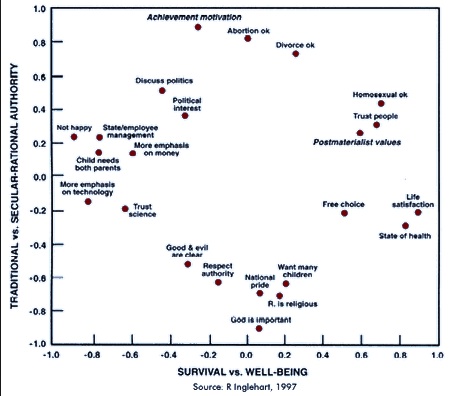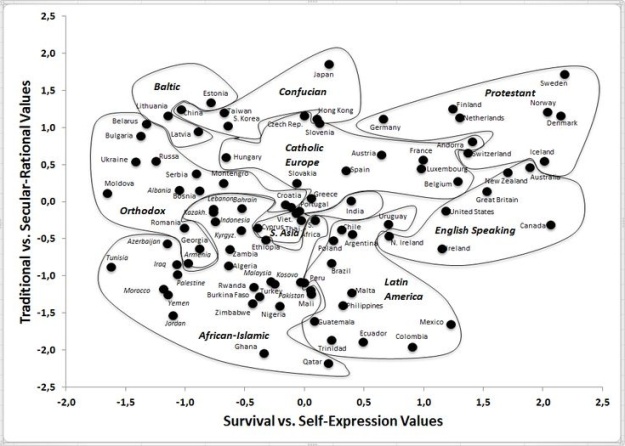December 2015 – December 2016
Since 1981, the World Values Survey Association has been carrying out surveys around the world regarding people’s values, asking respondents, for example, whether most people can be trusted, and whether they are proud of their country. A lot of the variation in values across countries falls along two axes, survival versus well-being and self-expression, and tradition versus secular rationality, shown as the x and y axes in the chart below.

In societies high on survival and low on well-being (left on the x axis), people tend be less trusting and less happy, and to value money and material well-being more than emotionally rewarding careers. In societies high on traditional authority (low on the y axis), people are more patriotic and more religious.
We can also plot countries around the world by their positions on the two axes, as in the chart below.

A few observations: Confirming everyone’s stereotypes, Sweden is extreme both in post-materialism, and in post-traditionalism. The Anglosphere is more traditional than the Continental Protestant world, and Latin America more traditional than the Continental Catholic world. Soviet Communism did a moderately effective job of destroying traditional values, and a really good job of leaving people miserable.
Values change over time. Economic changes tend to result in changing values, while changing values tend to result in changing political institutions. More specifically, the growth of industrial employment tends to move societies up the y axis, away from traditional values, without shifting them much on the x-axis. The history of rapidly industrializing late nineteenth- and early-twentieth century Europe reflects this value shift, with new ideologies and leaders bypassing or assaulting traditional hierarchies of aristocracy and Church while fighting ruthlessly to make sure their followers came out on top in the struggle for existence.
More recent economic changes, toward post-industrialism, tend to move societies rightward on the x axis. The declining levels of violence documented by Pinker, as well our halting progress toward a more democratic world, are reflections of this. These are encouraging developments, but matters are complicated by the fact that this movement is highly uneven, both across and within countries. We no longer see the stark divisions of the Cold War era. But in many areas around the world, people find themselves in a house divided against itself on cultural matters, and this division can make for more conflict. Political scientists have coined a label for this, Center-Periphery Dissonance, and many of the revolutionary political struggle of the last several years have pitted a modernizing center against a more traditional periphery.
